Glacier Variations at Xinqingfeng and Malan Ice Caps in the Inner Tibetan Plateau Since 1970
Abstract
1. Introduction
2. Study Area
3. Data and Methods
3.1. Topographic Maps
3.2. ASTER
3.3. TerraSAR-X/TanDEM-X
3.4. SRTM and Radar Penetration
3.5. Glacier Velocity Data
3.6. Glacier Boundary Mapping, and the Calculation of the Area Change and Uncertainty
3.7. Glacier Elevation Changes, Mass Balance, and Uncertainty
4. Results
4.1. Glacier Area Changes
4.2. Glacier Mass Balance
4.3. Glacier Advance and Surge
5. Discussion
5.1. Uncertainties
5.2. Glacier Area Changes
5.3. Glacier Mass Changes
5.4. Glacier Advance and Surge
5.5. Glacier Response to Climate Change
6. Conclusions
Supplementary Materials
Author Contributions
Funding
Acknowledgments
Conflicts of Interest
References
- Immerzeel, W.W.; van Beek, L.P.; Bierkens, M.F. Climate change will affect the asian water towers. Science 2010, 328, 1382–1385. [Google Scholar] [CrossRef]
- Brun, F.; Berthier, E.; Wagnon, P.; Kaab, A.; Treichler, D. A spatially resolved estimate of high mountain asia glacier mass balances, 2000-2016. Nat. Geosci. 2017, 10, 668–673. [Google Scholar] [CrossRef]
- Kääb, A.; Berthier, E.; Nuth, C.; Gardelle, J.; Arnaud, Y. Contrasting patterns of early twenty-first-century glacier mass change in the himalayas. Nature 2012, 488, 495–498. [Google Scholar] [CrossRef]
- Kääb, A.; Treichler, D.; Nuth, C.; Berthier, E. Brief communication: Contending estimates of 2003-2008 glacier mass balance over the pamir–karakoram–himalaya. Cryosphere 2015, 9, 557–564. [Google Scholar] [CrossRef]
- Wu, K.; Liu, S.; Jiang, Z.; Xu, J.; Wei, J.; Guo, W. Recent glacier mass balance and area changes in the kangri karpo mountains from dems and glacier inventories. Cryosphere 2018, 12, 103–121. [Google Scholar] [CrossRef]
- Farinotti, D.; Longuevergne, L.; Moholdt, G.; Duethmann, D.; Mölg, T.; Bolch, T.; Vorogushyn, S.; Güntner, A. Substantial glacier mass loss in the tien shan over the past 50 years. Nat. Geosci. 2015, 8, 716–722. [Google Scholar] [CrossRef]
- Holzer, N.; Vijay, S.; Yao, T.; Xu, B.; Buchroithner, M.; Bolch, T. Four decades of glacier variations at muztagh ata (eastern pamir): A multi-sensor study including hexagon kh-9 and pléiades data. Cryosphere 2015, 9, 2071–2088. [Google Scholar] [CrossRef]
- Zhang, Z.; Liu, S.; Wei, J.; Xu, J.; Guo, W.; Bao, W.; Jiang, Z. Mass change of glaciers in muztag ata-kongur tagh, eastern pamir, china from 1971/76 to 2013/14 as derived from remote sensing data. PLoS ONE 2016, 11, e0147327. [Google Scholar] [CrossRef]
- Bolch, T.; Pieczonka, T.; Mukherjee, K.; Shea, J. Brief communication: Glaciers in the hunza catchment (karakoram) have been nearly in balance since the 1970s. Cryosphere 2017, 11, 531–539. [Google Scholar] [CrossRef]
- Lin, H.; Li, G.; Cuo, L.; Hooper, A.; Ye, Q. A decreasing glacier mass balance gradient from the edge of the upper tarim basin to the karakoram during 2000-2014. Sci. Rep. 2017, 7, 6712. [Google Scholar] [CrossRef]
- Gardelle, J.; Berthier, E.; Arnaud, Y. Slight mass gain of karakoram glaciers in the early twenty-first century. Nat. Geosci. 2012, 5, 322–325. [Google Scholar] [CrossRef]
- Gardelle, J.; Berthier, E.; Arnaud, Y.; Kääb, A. Region-wide glacier mass balances over the pamir-karakoram-himalaya during 1999-2011. Cryosphere 2013, 7, 1263–1286. [Google Scholar] [CrossRef]
- Bao, W.; Liu, S.; Wei, J.; Guo, W. Glacier changes during the past 40 years in the west kunlun shan. J. Mt. Sci.-Engl. 2015, 12, 344–357. [Google Scholar] [CrossRef]
- Yao, T.D.; Thompson, L.; Yang, W.; Yu, W.S.; Gao, Y.; Guo, X.J.; Yang, X.X.; Duan, K.Q.; Zhao, H.B.; Xu, B.Q.; et al. Different glacier status with atmospheric circulations in tibetan plateau and surroundings. Nat. Clim. Chang. 2012, 2, 663–667. [Google Scholar] [CrossRef]
- Zhang, Z.; Liu, S. Area changes and mass balance of glaciers in kangzhagri of the tibetan plateau from 1970 to 2016 as derived from remote sensing data. J. Geo-Inf. Sci. 2018, 20, 1338–1349. [Google Scholar]
- Neckel, N.; Braun, A.; Kropáček, J.; Hochschild, V. Recent mass balance of the purogangri ice cap, central tibetan plateau, by means of differential x-band sar interferometry. Cryosphere 2013, 7, 1623–1633. [Google Scholar] [CrossRef]
- Chen, A.A.; Wang, N.; Li, Z.; Wu, Y.; Zhang, W.; Guo, Z. Region-wide glacier mass budgets for the tanggula mountains between ∼1969 and ∼2015 derived from remote sensing data. Arct. Antarct. Alp. Res. 2017, 49, 551–568. [Google Scholar] [CrossRef]
- Motyka, R.J.; Truffer, M. Hubbard glacier, alaska: 2002 closure and outburst of russell fjord and postflood conditions at gilbert point. J. Geophys. Res. 2007, 112, F02004. [Google Scholar] [CrossRef]
- Kotlyakov, V.M.; Rototaeva, O.V.; Nosenko, G.A. The september 2002 kolka glacier catastrophe in north ossetia, russian federation: Evidence and analysis. Mt. Res. Dev. 2004, 24, 78–83. [Google Scholar] [CrossRef]
- Sevestre, H.; Benn, D.I. Climatic and geometric controls on the global distribution of surge-type glaciers: Implications for a unifying model of surging. J. Glaciol. 2015, 61, 646–662. [Google Scholar] [CrossRef]
- Kotlyakov, V.M.; Osipova, G.B.; Tsvetkov, D.G. Monitoring surging glaciers of the pamirs, central asia, from space. Ann. Glaciol. 2008, 48, 125–134. [Google Scholar] [CrossRef]
- Shangguan, D.H.; Liu, S.Y.; Ding, Y.J.; Guo, W.Q.; Xu, B.Q.; Xu, J.L.; Jiang, Z.L. Characterizing the may 2015 karayaylak glacier surge in the eastern pamir plateau using remote sensing. J. Glaciol. 2016, 62, 944–953. [Google Scholar] [CrossRef]
- Lv, M.; Guo, H.; Lu, X.; Liu, G.; Yan, S.; Ruan, Z.; Ding, Y.; Quincey, D.J. Characterizing the behaviour of surge- and non-surge-type glaciers in the kingata mountains, eastern pamir, from 1999 to 2016. Cryosphere 2019, 13, 219–236. [Google Scholar] [CrossRef]
- Copland, L.; Sylvestre, T.; Bishop, M.P.; Shroder, J.F.; Seong, Y.B.; Owen, L.A.; Bush, A.; Kamp, U. Expanded and recently increased glacier surging in the karakoram. Arct. Antarct. Alp. Res. 2011, 43, 503–516. [Google Scholar] [CrossRef]
- Round, V.; Leinss, S.; Huss, M.; Haemmig, C.; Hajnsek, I. Surge dynamics and lake outbursts of kyagar glacier, karakoram. Cryosphere 2017, 11, 723–739. [Google Scholar] [CrossRef]
- Bhambri, R.; Hewitt, K.; Kawishwar, P.; Pratap, B. Surge-type and surge-modified glaciers in the karakoram. Sci. Rep. 2017, 7, 15391. [Google Scholar] [CrossRef]
- Steiner, J.F.; Kraaijenbrink, P.D.A.; Jiduc, S.G.; Immerzeel, W.W. Brief communication: The khurdopin glacier surge revisited—Extreme flow velocities and formation of a dammed lake in 2017. Cryosphere 2018, 12, 95–101. [Google Scholar] [CrossRef]
- Mukherjee, K.; Bolch, T.; Goerlich, F.; Kutuzov, S.; Osmonov, A.; Pieczonka, T.; Shesterova, I. Surge-type glaciers in the tien shan (central asia). Arct. Antarct. Alp. Res. 2018, 49, 147–171. [Google Scholar] [CrossRef]
- Pieczonka, T.; Bolch, T. Region-wide glacier mass budgets and area changes for the central tien shan between ~ 1975 and 1999 using hexagon kh-9 imagery. Glob. Planet. Chang. 2015, 1–13. [Google Scholar] [CrossRef]
- Zhang, Z.; Liu, S.; Zhang, Y.; Wei, J.; Jiang, Z.; Wu, K. Glacier variations at aru co in western tibet from 1971 to 2016 derived from remote-sensing data. J. Glaciol. 2018, 64, 397–406. [Google Scholar] [CrossRef]
- Jiang, Z.; Liu, S.; Guo, W.; Li, J.; Long, S.; Wang, X.; Wei, J.; Zhang, Z.; Wu, K. Recent surface elevation changes of three representative glaciers in nyêmaqên mountains, source region of yellow river. J. Glaciol. Geocryol. 2018, 40, 231–237. [Google Scholar]
- Guo, W.Q.; Liu, S.Y.; Wei, J.F.; Bao, W.J. The 2008/09 surge of central yulinchuan glacier, northern tibetan plateau, as monitored by remote sensing. Ann. Glaciol. 2013, 54, 299–310. [Google Scholar] [CrossRef]
- Xu, J.; Shangguan, D.; Wang, J. Three-dimensional glacier changes in geladandong peak region in the central tibetan plateau. Water 2018, 10, 1749. [Google Scholar] [CrossRef]
- Zhang, W. A surging glacier in the nanjiabawa peak area, himalayas. J. Glaciol. Geocryol. 1983, 5, 75–76. [Google Scholar]
- Kääb, A.; Leinss, S.; Gilbert, A.; Bühler, Y.; Gascoin, S.; Evans, S.G.; Bartelt, P.; Berthier, E.; Brun, F.; Chao, W.-A.; et al. Massive collapse of two glaciers in western tibet in 2016 after surge-like instability. Nat. Geosci. 2018, 11, 114–120. [Google Scholar]
- Zhou, Y.S.; Hu, J.; Li, Z.W.; Li, J.; Zhao, R.; Ding, X.L. Quantifying glacier mass change and its contribution to lake growths in central kunlun during 2000-2015 from multi-source remote sensing data. J. Hydrol. 2019, 570, 38–50. [Google Scholar] [CrossRef]
- Wei, J.; Liu, S.; Guo, W.; Xu, J.; Bao, W.; Shangguan, D. Changes in glacier volume in the north bank of the bangong co basin from 1968 to 2007 based on historical topographic maps, srtm, and aster stereo images. Arct. Antarct. Alp. Res. 2015, 47, 301–311. [Google Scholar]
- Wei, J.; Liu, S.; Xu, J.; Guo, W.; Bao, W.; Shangguan, D.; Jiang, Z. Mass loss from glaciers in the chinese altai mountains between 1959 and 2008 revealed based on historical maps, srtm, and aster images. J. Mt. Sci.-Engl. 2015, 12, 330–343. [Google Scholar] [CrossRef]
- Liu, S.; Shangguan, D.; Ding, Y.; Han, H.; Zhang, Y.; Wang, J.; Xie, C.; Ding, L.; Li, G. Variation of glaciers studied on the basis of rs and gis: A reassessment of the changes of the xinqingfeng and malan ice caps in the northern tibetan plateau. J. Glaciol. Geocryol. 2004, 26, 244–252. [Google Scholar]
- Li, B. Nature Environment in the Hoh Xil Region of Qinghai; Science Press: Beijing, China, 1996. [Google Scholar]
- Xie, Z.; Han, J.; Feng, Q.; Wang, X. Primary study on the glaciers of mountain malan, hoh xil region, qinghai-xizang plateau. J. Nat. Sci. Hunan Norm. Univ. 2000, 23, 83–88. [Google Scholar]
- Wang, Y.; Pu, J.; Zhang, Y.; Sun, W. Characteristic of present warming change recorded in malan ice core, central tibetan plateau. J. Glaciol. Geocryol. 2003, 25, 130–134. [Google Scholar]
- GB/T12343.1-2008. Compilation Specifications for National Fundamental Scale Mapse—Part 1: Compilation Specifications for 1:25000/1:50000/1:100000 Topographic Maps; General Administration of Quality Supervision Inspection and Quarantine: Beijing, China, 2008. [Google Scholar]
- Wang, H.; Hu, J.; Tan, Q.; Xu, X. Evaluation of the contour line interpolation generated dems of mountainous area in north china. Contrib. Geol. Miner. Resour. Res. 2014, 29, 433–437. [Google Scholar]
- Liu, L.; Jiang, L.; Jiang, H.; Wang, H.; Ma, N.; Xu, H. Accelerated glacier mass loss (2011–2016) over the puruogangri ice field in the inner tibetan plateau revealed by bistatic insar measurements. Remote Sens. Environ. 2019, 231, 111241. [Google Scholar] [CrossRef]
- Kamp, U.; Bolch, T.; Olsenholler, J. DEM generation from aster satellite data for geomorphometric analysis of cerro sillajhuay, chile/bolivia. In Proceedings of the ASPRS 2003 Annual Conference, Anchorage, AK, USA, 5–9 May 2003. [Google Scholar]
- Krieger, G.; Moreira, A.; Fiedler, H.; Hajnsek, I.; Werner, M.; Younis, M.; Zink, M. Tandem-x: A satellite formation for high-resolution sar interferometry. IEEE Trans. Geosci. Remote Sens. 2007, 45, 3317–3341. [Google Scholar] [CrossRef]
- Costantini, M. A novel phase unwrapping method based on network programming. IEEE Trans. Geosci. Remote Sens. 1998, 36, 813–821. [Google Scholar] [CrossRef]
- Berthier, E.; Arnaud, Y.; Vincent, C.; Rémy, F. Biases of srtm in high-mountain areas: Implications for the monitoring of glacier volume changes. Geophys. Res. Lett. 2006, 33, L08502. [Google Scholar] [CrossRef]
- Gardelle, J.; Berthier, E.; Arnaud, Y. Impact of resolution and radar penetration on glacier elevation changes computed from dem differencing. J. Glaciol. 2012, 58, 419–422. [Google Scholar] [CrossRef]
- Shangguan, D.H.; Bolch, T.; Ding, Y.J.; Kröhnert, M.; Pieczonka, T.; Wetzel, H.U.; Liu, S.Y. Mass changes of southern and northern inylchek glacier, central tian shan, kyrgyzstan, during ∼1975 and 2007 derived from remote sensing data. Cryosphere 2015, 9, 703–717. [Google Scholar] [CrossRef]
- Gardner, A.S.; Moholdt, G.; Scambos, T.; Fahnstock, M.; Ligtenberg, S.; van den Broeke, M.; Nilsson, J. Increased west antarctic and unchanged east antarctic ice discharge over the last 7 years. Cryosphere 2018, 12, 521–547. [Google Scholar] [CrossRef]
- Fahnestock, M.; Scambos, T.; Moon, T.; Gardner, A.; Haran, T.; Klinger, M. Rapid large-area mapping of ice flow using landsat 8. Remote Sens. Environ. 2016, 185, 84–94. [Google Scholar] [CrossRef]
- Sam, L.; Bhardwaj, A.; Kumar, R.; Buchroithner, M.F.; Martin-Torres, F.J. Heterogeneity in topographic control on velocities of western himalayan glaciers. Sci. Rep. 2018, 8, 12843. [Google Scholar] [CrossRef] [PubMed]
- Guo, W.; Liu, S.; Xu, J.; Wu, L.; Shangguan, D.; Yao, X.; Wei, J.; Bao, W.; Yu, P.; Liu, Q.; et al. The second chinese glacier inventory: Data, methods and results. J. Glaciol. 2015, 61, 357–372. [Google Scholar] [CrossRef]
- Wei, J.F.; Liu, S.Y.; Guo, W.Q.; Yao, X.J.; Xu, J.L.; Bao, W.J.; Jiang, Z.L. Surface-area changes of glaciers in the tibetan plateau interior area since the 1970s using recent landsat images and historical maps. Ann. Glaciol. 2014, 55, 213–222. [Google Scholar]
- Nuth, C.; Kääb, A. Co-registration and bias corrections of satellite elevation data sets for quantifying glacier thickness change. Cryosphere 2011, 5, 271–290. [Google Scholar] [CrossRef]
- Fischer, M.; Huss, M.; Hoelzle, M. Surface elevation and mass changes of all swiss glaciers 1980–2010. Cryosphere 2015, 9, 525–540. [Google Scholar] [CrossRef]
- Huss, M. Density assumptions for converting geodetic glacier volume change to mass change. Cryosphere 2013, 7, 877–887. [Google Scholar] [CrossRef]
- Bolch, T.; Pieczonka, T.; Benn, D.I. Multi-decadal mass loss of glaciers in the everest area (nepal himalaya) derived from stereo imagery. Cryosphere 2011, 5, 349–358. [Google Scholar] [CrossRef]
- Lambrecht, A.; Mayer, C.; Wendt, A.; Floricioiu, D.; Volksen, C. Elevation change of fedchenko glacier, pamir mountains, from gnss field measurements and tandem-x elevation models, with a focus on the upper glacier. J. Glaciol. 2018, 64, 637–648. [Google Scholar] [CrossRef]
- Ye, Q.; Zong, J.; Tian, L.; Cogley, J.G.; Song, C.; Guo, W. Glacier changes on the tibetan plateau derived from landsat imagery: Mid-1970s–2000–13. J. Glaciol. 2017, 63, 273–287. [Google Scholar] [CrossRef]
- Wang, Y.; Wu, L.; Xu, J.; Liu, S. Variation and uncertainty analysis of the glaciers in the past 50 years in geladandong of tibetan plateau. J. Glaciol. Geocryol. 2013, 35, 255–262. [Google Scholar]
- Qiao, C. Remote sensing monitoring of glacier changes in dongkemadi region of tanggula mountain. J. Anhui Agric. Sci. 2010, 38, 7703–7705. [Google Scholar]
- Sun, M.; Liu, S.; Yao, X.; Guo, W.; Xu, J. Glacier changes in the qilian mountains in the past half-century: Based on the revised first and second chinese glacier inventory. J. Geogr. Sci. 2018, 28, 206–220. [Google Scholar] [CrossRef]
- Liu, Q.; Guo, W.; Nie, Y.; Liu, S.; Xu, J. Recent glacier and glacial lake changes and their interactions in the bugyai kangri, southeast tibet. Ann. Glaciol. 2015, 51, 61–69. [Google Scholar] [CrossRef]
- Wu, K.; Liu, S.; Guo, W.; Wei, J.; Xu, J.; Bao, W.; Yao, X. Glcier change in the western nyainqentanglha range, tibetan plateau using historical maps and landsat imagery:1970-2014. J. Mt. Sci.-Engl. 2016, 13, 1358–1374. [Google Scholar] [CrossRef]
- Gardner, A.S.; Moholdt, G.; Cogley, J.G.; Wouters, B.; Arendt, A.A.; Wahr, J.; Berthier, E.; Hock, R.; Pfeffer, W.T.; Kaser, G.; et al. A reconciled estimate of glacier contributions to sea level rise: 2003 to 2009. Science 2013, 340, 852–857. [Google Scholar] [CrossRef]
- Neckel, N.; Kropáček, J.; Bolch, T.; Hochschild, V. Glacier mass changes on the tibetan plateau 2003–2009 derived from icesat laser altimetry measurements. Environ. Res. Lett. 2014, 9, 1–7. [Google Scholar] [CrossRef]
- Sakai, A.; Nuimura, T.; Fujita, K.; Takenaka, S.; Nagai, H.; Lamsal, D. Climate regime of asian glaciers revealed by gamdam glacier inventory. Cryosphere 2015, 9, 865–880. [Google Scholar] [CrossRef]
- Falaschi, D.; Bolch, T.; Lenzano, M.G.; Tadono, T.; Lo Vecchio, A.; Lenzano, L. New evidence of glacier surges in the central andes of argentina and chile. Prog. Phys. Geogr. Earth Environ. 2018, 42, 792–825. [Google Scholar] [CrossRef]
- Quincey, D.J.; Glasser, N.F.; Cook, S.J.; Luckman, A. Heterogeneity in karakoram glacier surges. J. Geophys. Res. Earth Surf. 2015, 120, 1288–1300. [Google Scholar] [CrossRef]
- Clarke, G.K.C.; Collins, S.G.; Thompson, D.E. Flow, thermal structure, and subglacial conditions of a surge-type glacier. Can. J. Earth Sci. 1984, 21, 232–240. [Google Scholar] [CrossRef]
- Murray, T.; Stuart, G.W.; Miller, P.J.; Woodward, J.; Smith, A.M.; Porter, P.R.; Jiskoot, H. Glacier surge propagation by thermal evolution at the bed. J. Geophys. Res. 2000, 105, 13491. [Google Scholar] [CrossRef]
- Fowler, A.C.; Murray, T.; Ng, F.S.L. Thermally controlled glacier surging. J. Glaciol. 2001, 47, 527–538. [Google Scholar] [CrossRef]
- Sevestre, H.; Benn, D.I.; Hulton, N.R.J.; Baelum, K. Thermal structure of svalbard glaciers and implications for thermal switch models of glacier surging. J. Geophys. Res. Earth Surf. 2015, 120, 2220–2236. [Google Scholar] [CrossRef]
- Kamb, B.; Raymond, C.F.; Harrison, W.D.; Engelhardt, H.; Echelmeyer, K.A.; Humphrey, N.; Brugman, M.M.; Pfeffer, T. Glacier surge mechanism—1982-1983 surge of variegated glacier, alaska. Science 1985, 227, 469–479. [Google Scholar] [CrossRef]
- Björnsson, H. Hydrological characteristics of the drainage system beneath a surging glacier. Nature 1998, 395, 771–774. [Google Scholar] [CrossRef]
- Burgess, E.W.; Forster, R.R.; Larsen, C.F.; Braun, M. Surge dynamics on bering glacier, alaska, in 2008-2011. Cryosphere 2012, 6, 1251–1262. [Google Scholar] [CrossRef]
- Lingle, C.S.; Fatland, D.R. Does englacial water storage drive temperate glacier surges? Ann. Glaciol. 2003, 36, 14–20. [Google Scholar] [CrossRef]
- Wang, N. Variations in net accumulation rate of the malan ice core from the northern tibetan plateau over the period of 1887 though 1998 and their relationship to solar activity. Quat. Sci. 2009, 29, 913–919. [Google Scholar]
- Pu, J.; Yao, T.; Wang, N.; Ding, L.; Zhang, Q. Recent variation of the malan glacier in hoh xil region of the tibetan plateau. J. Glaciol. Geocryol. 2001, 23, 189–192. [Google Scholar]
- Bolch, T.; Kulkarni, A.; Kaab, A.; Huggel, C.; Paul, F.; Cogley, J.G.; Frey, H.; Kargel, J.S.; Fujita, K.; Scheel, M.; et al. The state and fate of himalayan glaciers. Science 2012, 336, 310–314. [Google Scholar] [CrossRef]
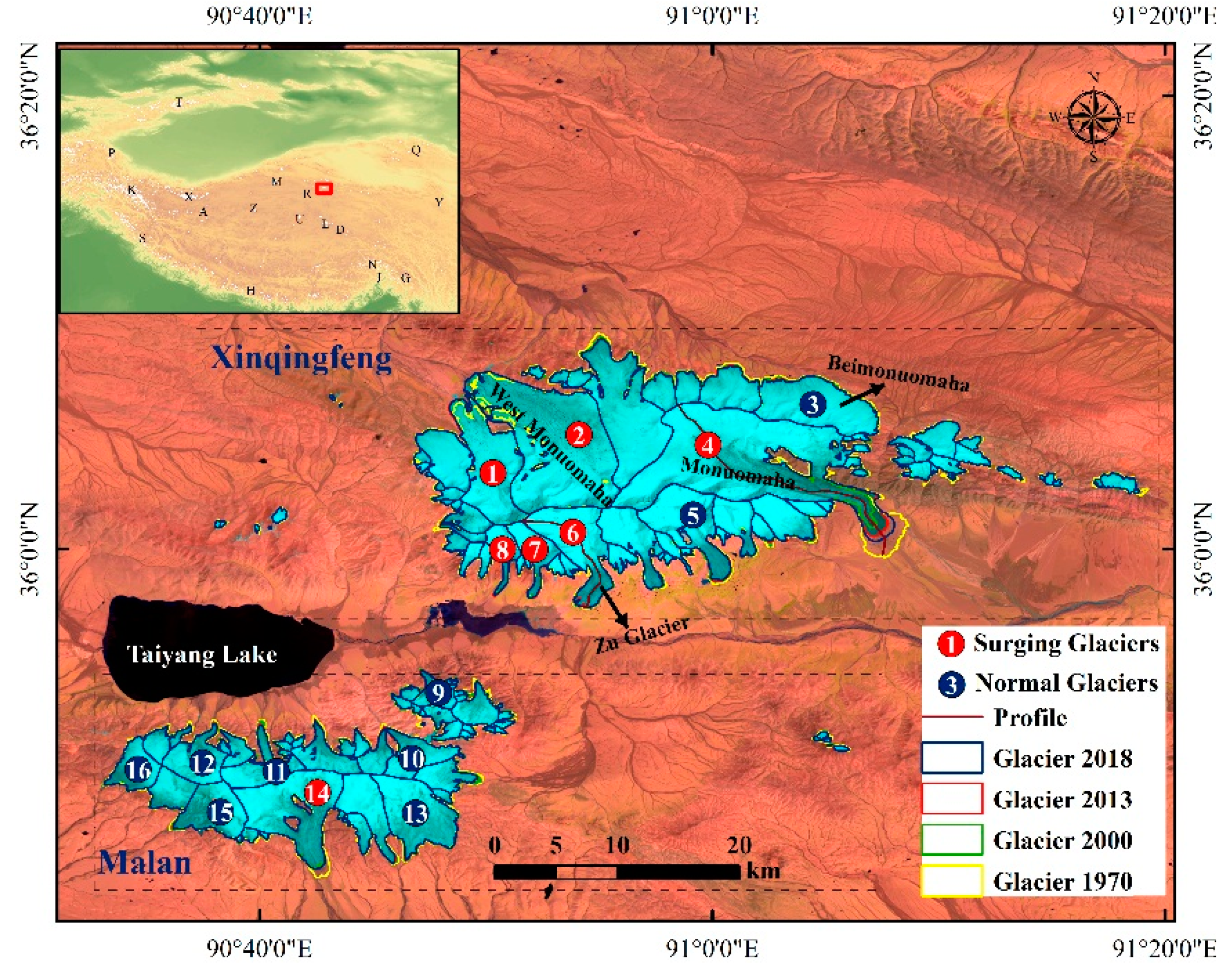

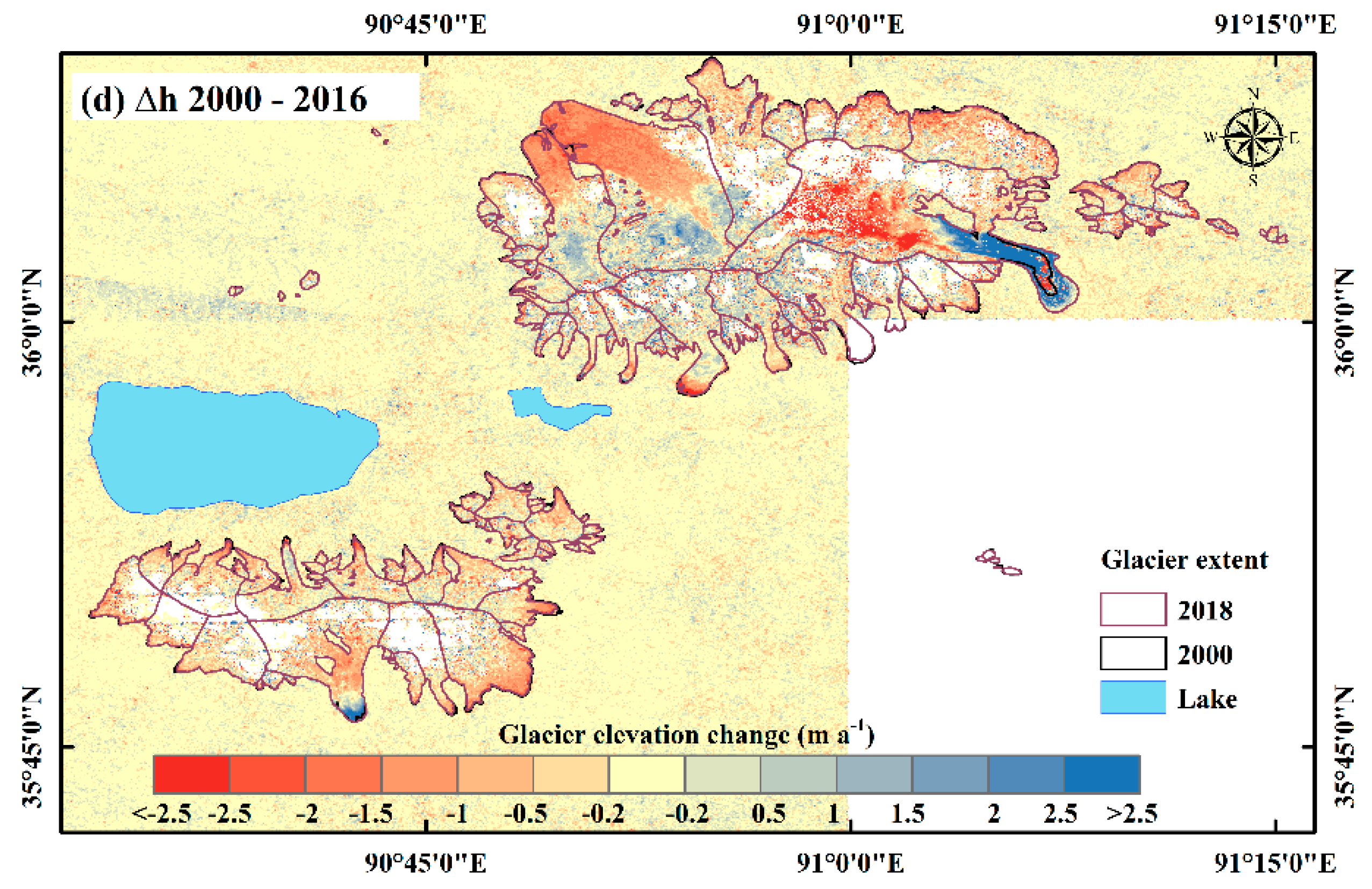
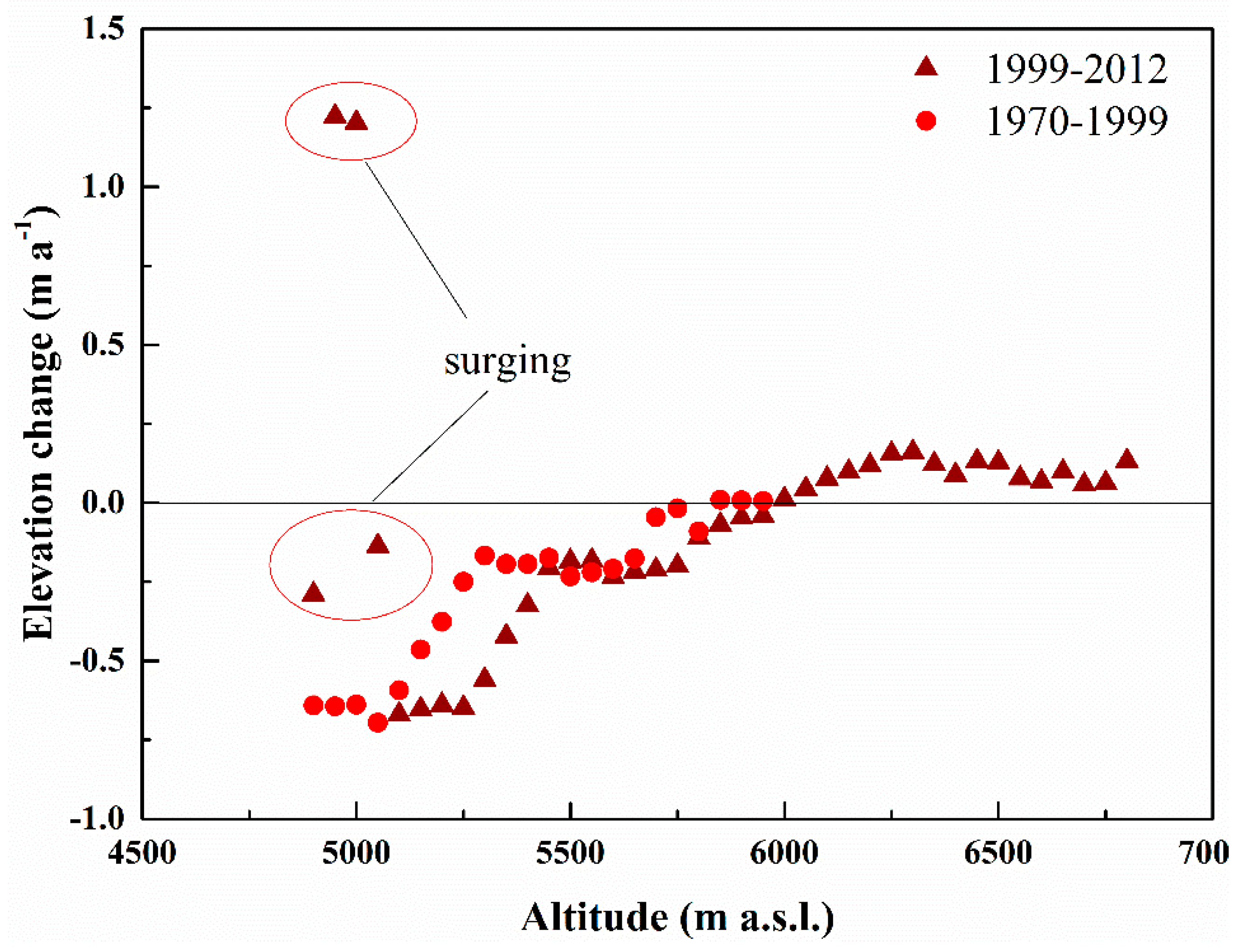



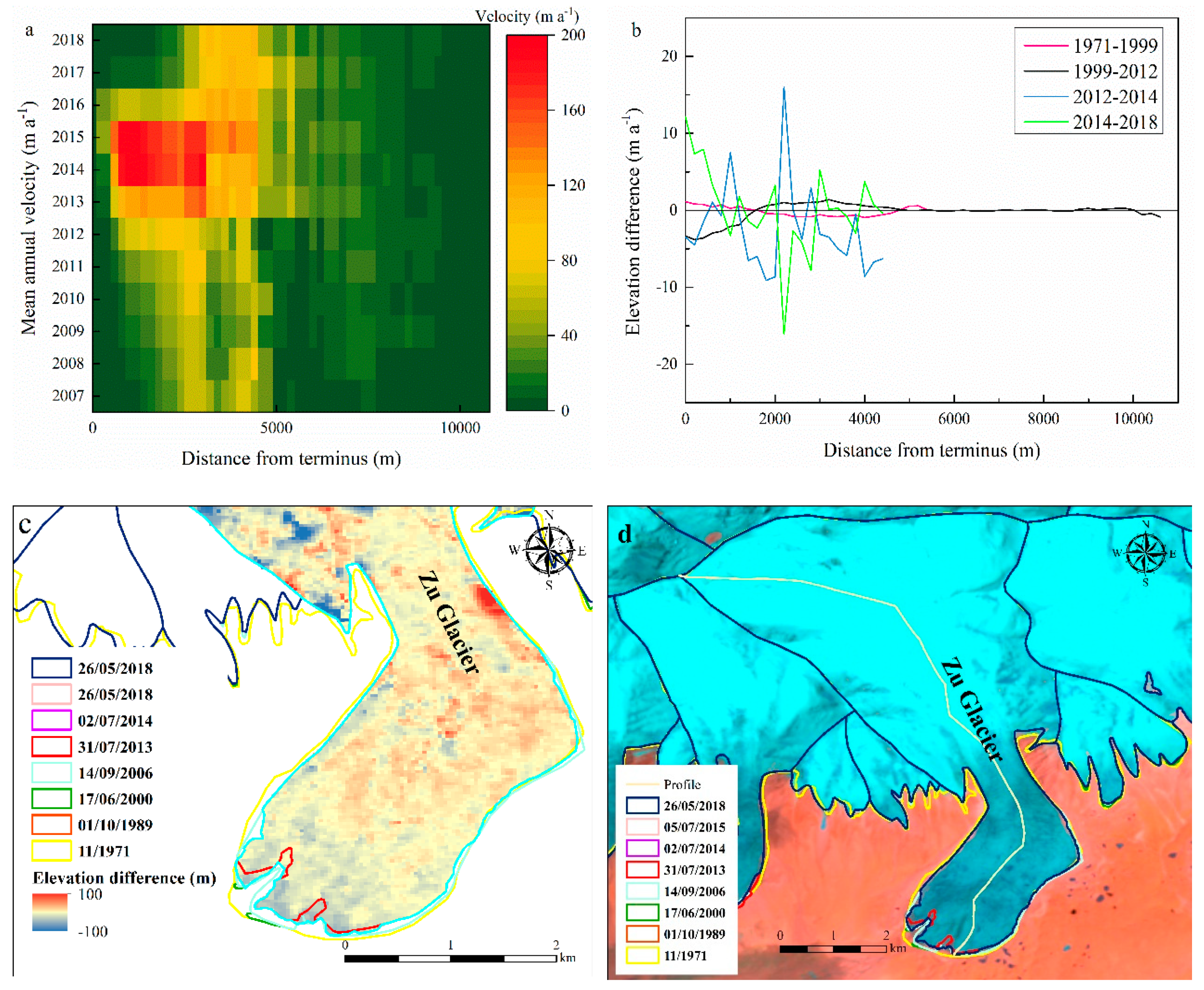
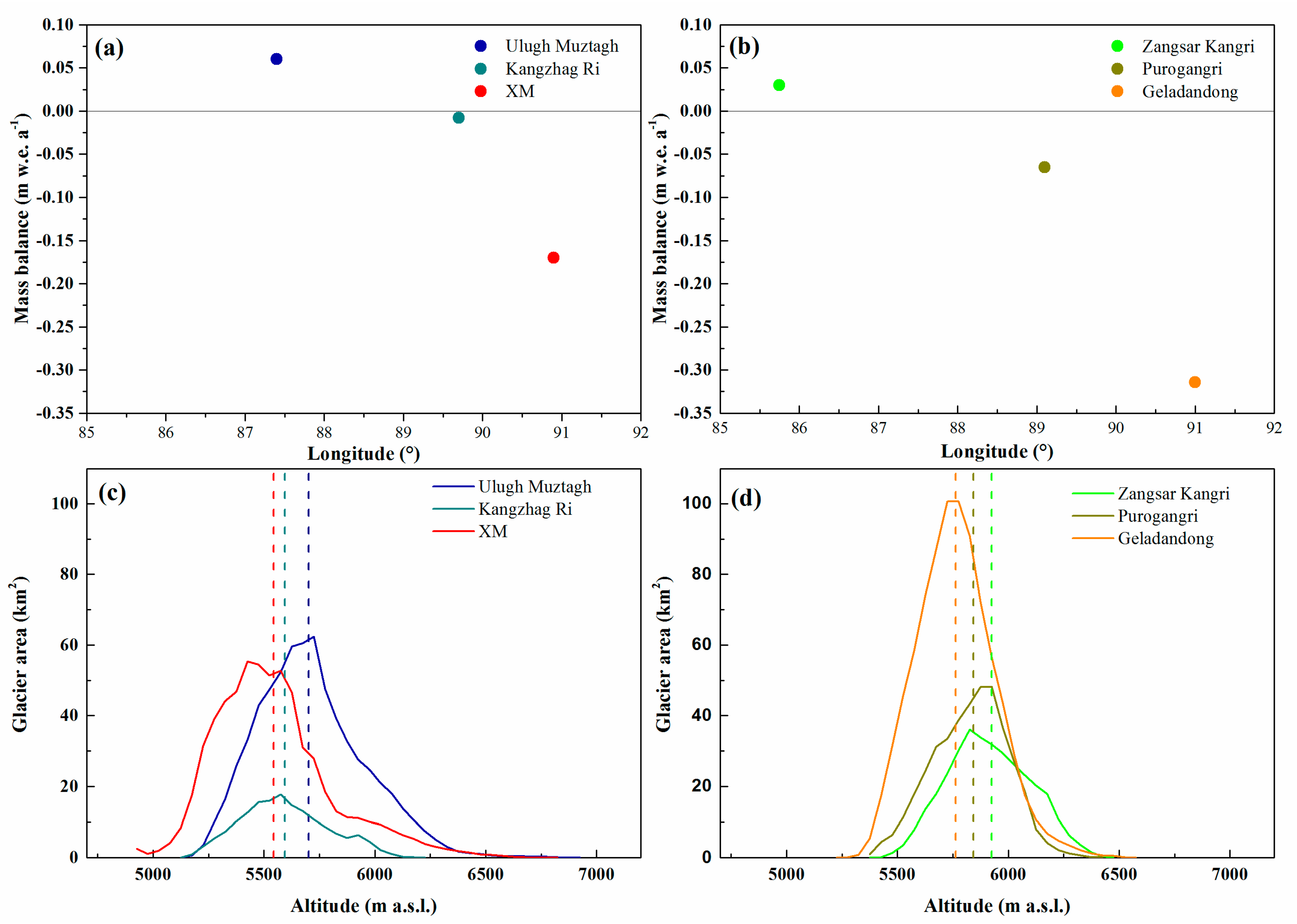
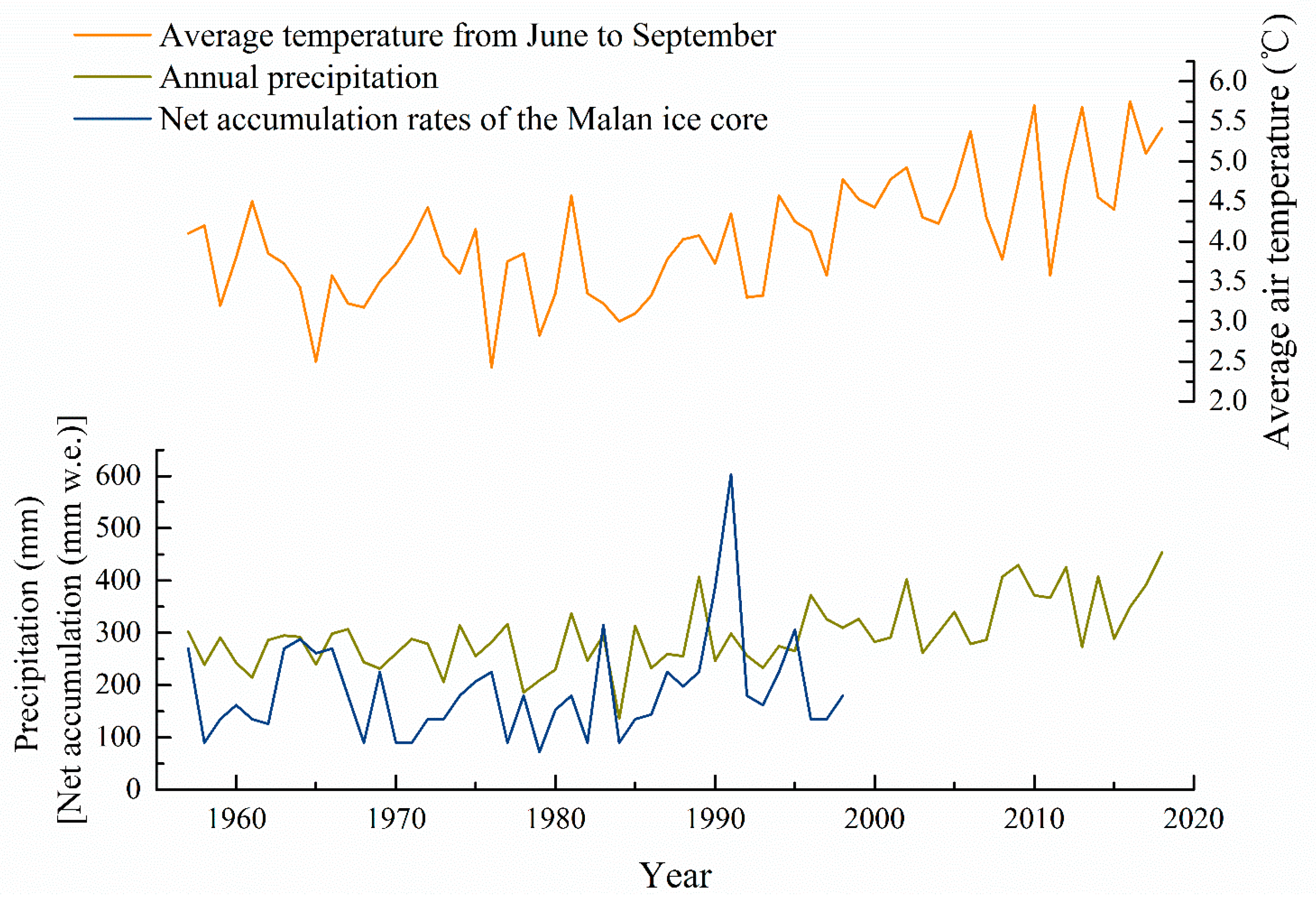
| Source | Acquisition Date | Space Resolution (m) | Usage |
|---|---|---|---|
| TerraSAR-X/TanDEM-X | 8 March 2011 5 March 2012 16 March 2012 29 April 2012 | 12 | Estimation of glacier elevation change |
| Topographic maps | October 1970 January 1971 November 1971 December 1971 | Glacier identification | |
| TOPO DEMs | October 1970 November 1971 December 1971 | 15 | Estimation of glacier elevation change |
| ASTER | 2014–2018 | 15 | Estimation of glacier elevation change |
| SRTM DEM (C-band and X-band) | 11–22 February 2000 | 30 | Estimation of glacier elevation change |
| Landsat 1~3/MSS | 1972~1976 | 79 | Glacier identification |
| Landsat 5/TM | 1986~2011 | 30 | Glacier identification |
| Landsat 7/ETM+ | 2000~2012 | Pan: 15; MS: 30 | Glacier identification |
| Landsat 8/OLI | 2013~2018 | Pan: 15; MS: 30 | Glacier identification |
| GoLIVE | 2013~2018 | 300 | Glacier velocity |
| ITS_LIVE | 1986–2018 | 480 | Glacier velocity |
| Item | MEAN (m) | STDV (m) | MIN (m) | MAX (m) |
|---|---|---|---|---|
| SRTM-TOPO | 0.49 | 10.20 | −91.12 | 96.40 |
| TSX/TDX-SRTM | −0.68 | 5.95 | −46.32 | 54.31 |
| TSX/TDX-TOPO | −0.63 | 10.57 | −50.85 | 33.23 |
| Region | ID | GLIMS ID | Advance Period | Advance (m) | Advance Rate (m a−1) | Relative Length Change (%) | Mean Slope (°) | Aspect |
|---|---|---|---|---|---|---|---|---|
| Xinqingfeng | 1 | G090837E36060N | 1971–1987 | 278.4 | 17.4 | 2.3 | 13.5 | N |
| 1989–1999 | 50.9 | 5.1 | 0.4 | |||||
| 2 | G090884E36076N | 1987–1989 | 1200 | 600 | 7.8 | 9.2 | NW | |
| 1990–1998 | 256 | 32 | 1.7 | |||||
| 4 | G091032E36060N | 2009–2016 | 1164 | 194 | 5.5 | 10.1 | E | |
| 6 | G090901E36002N | 2014–2016 | 46 | 23 | 0.4 | 17.7 | S | |
| 7 | G090868E35998N | 1986–1989 | 40.8 | 13.6 | 0.6 | 21.5 | S | |
| 2009–2010 | 107.8 | 107.8 | 1.6 | |||||
| 8 | G090846E36001N | 1970–1986 | 663 | 41.4 | 11.5 | 21.9 | S | |
| Malan | 14 | G090693E35807N | 2007–2012 | 260.5 | 52.1 | 2.8 | 7.6 | S |
© 2020 by the authors. Licensee MDPI, Basel, Switzerland. This article is an open access article distributed under the terms and conditions of the Creative Commons Attribution (CC BY) license (http://creativecommons.org/licenses/by/4.0/).
Share and Cite
Zhang, Z.; Liu, S.; Jiang, Z.; Shangguan, D.; Wei, J.; Guo, W.; Xu, J.; Zhang, Y.; Zhang, S.; Huang, D. Glacier Variations at Xinqingfeng and Malan Ice Caps in the Inner Tibetan Plateau Since 1970. Remote Sens. 2020, 12, 421. https://doi.org/10.3390/rs12030421
Zhang Z, Liu S, Jiang Z, Shangguan D, Wei J, Guo W, Xu J, Zhang Y, Zhang S, Huang D. Glacier Variations at Xinqingfeng and Malan Ice Caps in the Inner Tibetan Plateau Since 1970. Remote Sensing. 2020; 12(3):421. https://doi.org/10.3390/rs12030421
Chicago/Turabian StyleZhang, Zhen, Shiyin Liu, Zongli Jiang, Donghui Shangguan, Junfeng Wei, Wanqin Guo, Junli Xu, Yong Zhang, Shasha Zhang, and Danni Huang. 2020. "Glacier Variations at Xinqingfeng and Malan Ice Caps in the Inner Tibetan Plateau Since 1970" Remote Sensing 12, no. 3: 421. https://doi.org/10.3390/rs12030421
APA StyleZhang, Z., Liu, S., Jiang, Z., Shangguan, D., Wei, J., Guo, W., Xu, J., Zhang, Y., Zhang, S., & Huang, D. (2020). Glacier Variations at Xinqingfeng and Malan Ice Caps in the Inner Tibetan Plateau Since 1970. Remote Sensing, 12(3), 421. https://doi.org/10.3390/rs12030421







